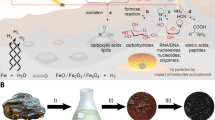Abstract
THE suggestion that the primitive atmosphere was highly reducing and consisted mainly of methane, ammonia and water vapour1 is supported by Miller's observation that amino-acids are formed by electrical discharges through such a mixture2 and the synthesis of various biomolecules under presumed primitive Earth atmospheres containing ammonia3. Bada and Miller4 point out that an ammonium ion concentration of 10−2 to 10−3 M is necessary for the synthesis of these biomolecules while Rasool and McGovern5 suggest that a methane–ammonia atmosphere could have been maintained for 109 years by a low leakage rate of hydrogen.
This is a preview of subscription content, access via your institution
Access options
Subscribe to this journal
Receive 51 print issues and online access
$199.00 per year
only $3.90 per issue
Buy this article
- Purchase on Springer Link
- Instant access to full article PDF
Prices may be subject to local taxes which are calculated during checkout
Similar content being viewed by others
References
Urey, H. C., Proc. US Nat. Acad. Sci., 38, 351 (1962).
Miller, S. L., J. Amer. Chem. Soc., 77, 2351 (1955).
Lemmon, R. M., Chem. Revs., 70, 95 (1970).
Bada, J. L., and Miller, S. L., Science, 159, 423 (1968).
Rasool, S. I., and McGovern, W. E., Nature, 212, 1225 (1966).
Rubey, W. W., Geol. Soc. Amer. Spec. Paper, 62, 363 (1955).
Cloud, P. E., Science, 160, 729 (1968).
Abelson, P. H., Proc. US Nat. Acad. Sci., 55, 1365 (1966).
Noyes, W. A., and Leighton, P. A., The Photochemistry of Gases, 374 (Dover, New York, 1966).
Brandt, J. C., The Physics and Astronomy of the Sun and Stars (McGraw-Hill, New York, 1966).
Harteck, P., Reeves, jun., R. R., and Thompson, B. A., Z. Naturforschg., 19a, 2 (1964).
Thompson, B. A., Reeves, jun., R. R., and Harteck, P., J. Phys. Chem., 69, 3964 (1965).
Buschmann, N. W., and Groth, W., Ber. Busenbes. Physik. Chem., 73, 859 (1969).
Calvert, J. G., and Pitts, jun., J. N., Photochemistry, 782 (John Wiley, New York, 1966).
Urey, H. C., The Planets, Their Origin and Development (Yale University Press, New York, 1952).
Holland, H. D., in The Origin and Evolution of Atmospheres and Oceans (edit. by Brancazio, P. J., and Cameron, A. G. W.), 86 (John Wiley, New York, 1964).
Miller, S. L., and Urey, H. C., Science, 130, 245 (1959).
Brinckman, R. T., J. Geophys. Res., 74, 5355 (1969).
Korowitz, N. H., and Miller, S. L., Fortschr. Chem. Org. Natstaffe, 20, 432 (1962).
Author information
Authors and Affiliations
Rights and permissions
About this article
Cite this article
FERRIS, J., NICODEM, D. Ammonia Photolysis and the Role of Ammonia in Chemical Revolution. Nature 238, 268–269 (1972). https://doi.org/10.1038/238268a0
Received:
Issue Date:
DOI: https://doi.org/10.1038/238268a0
This article is cited by
-
The Prebiotic Provenance of Semi-Aqueous Solvents
Origins of Life and Evolution of Biospheres (2020)
-
Carbonaceous Chondrite Meteorites: the Chronicle of a Potential Evolutionary Path between Stars and Life
Origins of Life and Evolution of Biospheres (2017)
-
Prebiotic Chemistry: What We Know, What We Don't
Evolution: Education and Outreach (2012)
-
Studies in the Mineral and Salt-Catalyzed Formation of RNA Oligomers
Origins of Life and Evolution of Biospheres (2006)
-
Nitrogen Fixation By Corona Discharge On The Early Precambrian Earth
Origins of Life and Evolution of Biospheres (2005)
Comments
By submitting a comment you agree to abide by our Terms and Community Guidelines. If you find something abusive or that does not comply with our terms or guidelines please flag it as inappropriate.



